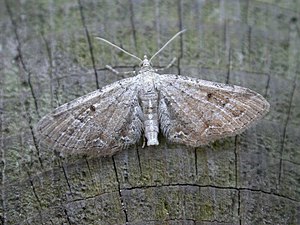Sign flyworms
| Sign flyworms | ||||||||||||
|---|---|---|---|---|---|---|---|---|---|---|---|---|

Report fly buds ( Eupithecia simpliciata ) |
||||||||||||
| Systematics | ||||||||||||
|
||||||||||||
| Scientific name | ||||||||||||
| Eupithecia simpliciata | ||||||||||||
| ( Haworth , 1809) |
The Flag Pug ( Eupithecia simpliciata ) ( synonym : Eupithecia subnotata ) is a butterfly ( moth ) from the family of the tensioner (Geometridae). Under the name "goosefoot pens", which was sometimes used in the past, the pacifier Eupithecia sinuosaria is now carried .
features
butterfly
The moths reach a wingspan of 17 to 25 millimeters. All wings have a pale yellow-gray to reddish brown basic color. The light transverse lines are weak. The white wavy line, which continues on the hind wings, clearly stands out. In the disk region there is a small round black spot on the upper side of the forewing. The fringes are not piebald.
Caterpillar
The caterpillars are greenish or brownish in color and usually show indistinct dark angular or diamond drawings on the back.
Doll
The pupa is brownish in color, the wing sheaths have a greenish sheen. The cone-shaped Kremaster is provided with two curved thorns and a few short hook bristles.
Distribution and occurrence
The species is distributed from the Iberian Peninsula through Central and Eastern Europe to Asia. The species primarily inhabits wastelands, rubble heaps and abandoned vineyards, and in Asia also salt steppes. In the Alps, the elevation ranges up to 1200 meters.
Way of life
The crepuscular and nocturnal moths fly in one generation in July and August, occasionally in June. For food they visit the flowers of water dost ( Eupatorium ) or hogweed species ( Heracleum ). During the night the moths occasionally fly to artificial light sources . The eggs are laid by the females on the underside of the leaves of the food plant near the flowers. The caterpillars live in August and September. They feed primarily on the flowers and fruits of logs ( Atriplex ) or goosefoot species ( Chenopodium ). Well camouflaged by their color, they usually stay on the flowers or seed heads. The pupae overwinter, sometimes twice.
Danger
The number of moths in Germany varies greatly in the individual federal states and is rare or endangered in the northern regions. Together with the spread of ruderal plants , the species has become a culture successor , similar to the goosefoot moth ( Eupithecia sinuosaria ) . An example of this was the numerous occurrences of the species on rubble sites in the 1955s and 1960s in the urban area of post-war Berlin . After the construction of new buildings and the associated loss of rubble fields, only individual observations were made. While the moths are usually only observed sporadically, the caterpillars appear locally more frequently every year. A development of new habitats appears possible in the future if the food plants spread further.
swell
Individual evidence
- ↑ Vladimir Mironov: The Geometrid Moths of the World . In: Axel Hausmann (Ed.): The Geometrid Moths of Europe . 1st edition. Volume 4: Larentiinae II. Perizomini and Eupitheciini . Apollo Books, Stenstrup 2003, ISBN 87-88757-40-4 (English).
- ↑ Walter Forster , Theodor A. Wohlfahrt : The butterflies of Central Europe. Volume 5: Spanner. (Geometridae). Franckh'sche Verlagshandlung, Stuttgart 1981, ISBN 3-440-04951-5 .
- ↑ a b c d e f Günter Ebert (Ed.): The butterflies of Baden-Württemberg. Volume 9. Moths VII. Geometridae 2nd part . 1st edition. Ulmer, Stuttgart (Hohenheim) 2003, ISBN 3-8001-3279-6 .
- ^ Josef Wolfsberger: New and interesting macrolepidoptera finds from southern Bavaria and the adjacent Northern Limestone Alps. In: Bavarian Entomologists' newsletter. , 1950.
- ↑ Arno Bergmann: The large butterflies of Central Germany. Volume 5/1: Spanner. Distribution, forms and communities. Urania-Verlag, Jena 1955, DNB 450378403 .
- ↑ Endangerment
- ^ Karl Cleve: The butterflies of West Berlin , Berliner Naturschutzblätter, Volksbund Naturschutz e. V., Volume 21, No. 62, 1977
- ↑ Manfred Koch , Wolfgang Heinicke, Bernd Müller: We determine butterflies. Volume 4: Spanner. 2nd, improved and enlarged edition. Neumann, Leipzig / Radebeul 1976, DNB 780451570 .
literature
- Vladimir Mironov: The Geometrid Moths of the World . In: Axel Hausmann (Ed.): The Geometrid Moths of Europe . 1st edition. Volume 4: Larentiinae II. Perizomini and Eupitheciini . Apollo Books, Stenstrup 2003, ISBN 87-88757-40-4 (English).
- Günter Ebert (Ed.): The butterflies of Baden-Württemberg. Volume 9. Moths VII. Geometridae 2nd part . 1st edition. Ulmer, Stuttgart (Hohenheim) 2003, ISBN 3-8001-3279-6 .
Web links
- Lepiforum e. V. - Taxonomy and photos
- kolumbus.fi - caterpillar
- ukmoths.org.uk - ukmoths